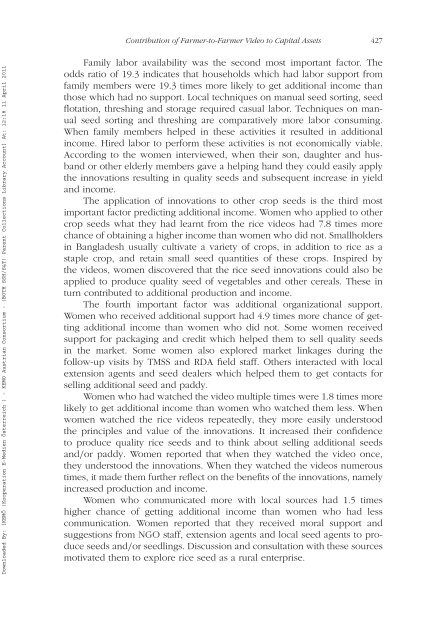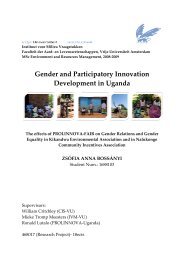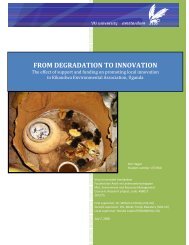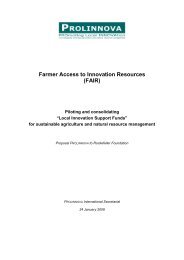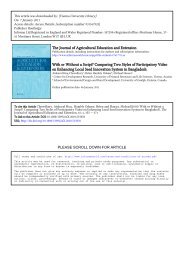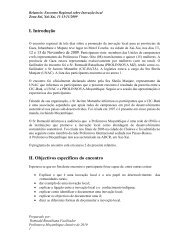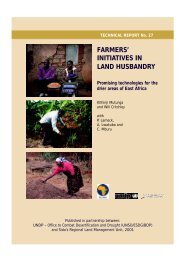Chowdhury et al (2011); PDF file - Prolinnova
Chowdhury et al (2011); PDF file - Prolinnova
Chowdhury et al (2011); PDF file - Prolinnova
You also want an ePaper? Increase the reach of your titles
YUMPU automatically turns print PDFs into web optimized ePapers that Google loves.
Contribution of Farmer-to-Farmer Video to Capit<strong>al</strong> Ass<strong>et</strong>s 427<br />
Downloaded By: [KEMÖ (Kooperation E-Medien Österreich ) - KEMO Austrian Consortium - (BOTH SSH/S&T) Parent Collections Library Account] At: 12:18 11 April <strong>2011</strong><br />
Family labor availability was the second most important factor. The<br />
odds ratio of 19.3 indicates that households which had labor support from<br />
family members were 19.3 times more likely to g<strong>et</strong> addition<strong>al</strong> income than<br />
those which had no support. Loc<strong>al</strong> techniques on manu<strong>al</strong> seed sorting, seed<br />
flotation, threshing and storage required casu<strong>al</strong> labor. Techniques on manu<strong>al</strong><br />
seed sorting and threshing are comparatively more labor consuming.<br />
When family members helped in these activities it resulted in addition<strong>al</strong><br />
income. Hired labor to perform these activities is not economic<strong>al</strong>ly viable.<br />
According to the women interviewed, when their son, daughter and husband<br />
or other elderly members gave a helping hand they could easily apply<br />
the innovations resulting in qu<strong>al</strong>ity seeds and subsequent increase in yield<br />
and income.<br />
The application of innovations to other crop seeds is the third most<br />
important factor predicting addition<strong>al</strong> income. Women who applied to other<br />
crop seeds what they had learnt from the rice videos had 7.8 times more<br />
chance of obtaining a higher income than women who did not. Sm<strong>al</strong>lholders<br />
in Bangladesh usu<strong>al</strong>ly cultivate a vari<strong>et</strong>y of crops, in addition to rice as a<br />
staple crop, and r<strong>et</strong>ain sm<strong>al</strong>l seed quantities of these crops. Inspired by<br />
the videos, women discovered that the rice seed innovations could <strong>al</strong>so be<br />
applied to produce qu<strong>al</strong>ity seed of veg<strong>et</strong>ables and other cere<strong>al</strong>s. These in<br />
turn contributed to addition<strong>al</strong> production and income.<br />
The fourth important factor was addition<strong>al</strong> organization<strong>al</strong> support.<br />
Women who received addition<strong>al</strong> support had 4.9 times more chance of g<strong>et</strong>ting<br />
addition<strong>al</strong> income than women who did not. Some women received<br />
support for packaging and credit which helped them to sell qu<strong>al</strong>ity seeds<br />
in the mark<strong>et</strong>. Some women <strong>al</strong>so explored mark<strong>et</strong> linkages during the<br />
follow-up visits by TMSS and RDA field staff. Others interacted with loc<strong>al</strong><br />
extension agents and seed de<strong>al</strong>ers which helped them to g<strong>et</strong> contacts for<br />
selling addition<strong>al</strong> seed and paddy.<br />
Women who had watched the video multiple times were 1.8 times more<br />
likely to g<strong>et</strong> addition<strong>al</strong> income than women who watched them less. When<br />
women watched the rice videos repeatedly, they more easily understood<br />
the principles and v<strong>al</strong>ue of the innovations. It increased their confidence<br />
to produce qu<strong>al</strong>ity rice seeds and to think about selling addition<strong>al</strong> seeds<br />
and/or paddy. Women reported that when they watched the video once,<br />
they understood the innovations. When they watched the videos numerous<br />
times, it made them further reflect on the benefits of the innovations, namely<br />
increased production and income.<br />
Women who communicated more with loc<strong>al</strong> sources had 1.5 times<br />
higher chance of g<strong>et</strong>ting addition<strong>al</strong> income than women who had less<br />
communication. Women reported that they received mor<strong>al</strong> support and<br />
suggestions from NGO staff, extension agents and loc<strong>al</strong> seed agents to produce<br />
seeds and/or seedlings. Discussion and consultation with these sources<br />
motivated them to explore rice seed as a rur<strong>al</strong> enterprise.


